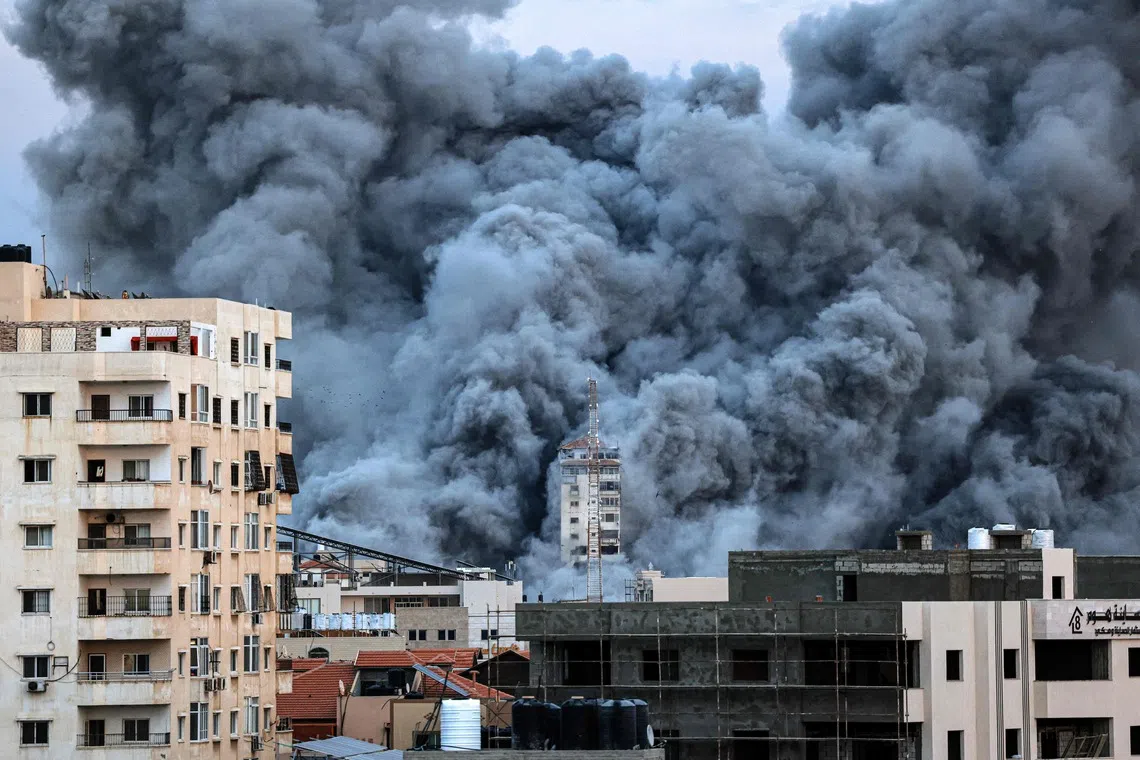What do we know about Trump’s Gaza deal?
Sign up now: Get ST's newsletters delivered to your inbox

A file photo from Oct 7, 2023, showing heavy smoke rising above buildings in Gaza City during an Israeli air strike.
PHOTO: AFP
Follow topic:
WASHINGTON – Israel and Hamas agreed on Oct 8 to the first phase of US President Donald Trump’s plan for Gaza
Here are some details of what is known and not known so far.
What do we know about the deal?
The agreement on the initial stage of Mr Trump’s 20-point framework resulted from indirect talks in Egypt, just a day after the second anniversary of Hamas’ attack on Israel
Mr Trump announced that both Israel and Hamas had signed off on the first phase of the plan and this would bring the release of all hostages, alive and dead, “very soon” and the withdrawal of Israeli troops to the so-called yellow line in Gaza.
According to a senior Israeli security source, that is a boundary for an initial Israeli pullback under the Trump plan.
Hamas confirmed it had reached an agreement to end the war that includes an Israeli withdrawal from Gaza and a hostage prisoner exchange, but the group called on Mr Trump and guarantor states to ensure Israel fully implements the ceasefire.
What are the main unknowns?
Despite the hopes raised for ending the war, crucial details are yet to be spelled out.
These include the timing, a post-war administration for the Gaza Strip, and the fate of Hamas.
There is no clear indication of who will rule Gaza when the war ends. Israeli Prime Minister Benjamin Netanyahu and President Trump, as well as Western and Arab states, have ruled out a role for Hamas, which has run Gaza since driving out Palestinian rivals in 2007.
Mr Trump's original 20-point plan
What happens next?
Mr Netanyahu said he would convene his government on Oct 9 to approve the agreement.
A Hamas source said the living hostages would be handed over within 72 hours of the Israeli government approving the deal.
Israel said the hostage release was expected to begin on Oct 11. Of the 48 hostages, 20 are still thought to be alive.
A senior White House official said that once Israel approves the deal, it has to withdraw to the agreed line, which should take under 24 hours, after which the 72-hour clock would begin.
The White House expects that the hostages will begin getting released on Oct 13.
Hamas said earlier on Oct 8 that it had handed over its lists of the hostages it held and the Palestinian prisoners held by Israel that it wanted to be exchanged.
Mr Trump is expected to travel to Egypt in the coming days, as the White House said he was considering going to the region on Oct 10.
Mr Netanyahu has invited Mr Trump to address Israel's Parliament, and Mr Trump told US news outlet Axios he would be willing to do that.
The next phase of Mr Trump's plan calls for an international body, called the “Board of Peace”, to play a role in Gaza’s post-war administration.
It is to be led by Mr Trump and includes former British prime minister Tony Blair.
What are the biggest risks to the deal?
Successful completion of the deal would mark the biggest foreign policy achievement so far for Mr Trump, who took office in January promising to quickly end the wars in Gaza and Ukraine, only to find that they were more difficult to resolve than he had hoped.
Hamas has so far refused to discuss Israel’s demand that the militant group give up its arms.
A Palestinian source said Hamas would reject this as long as Israeli troops occupy Palestinian land.
Two sources familiar with the talks confirmed that sticking points included the mechanism for the Israeli withdrawal, with Hamas seeking a clear timeline linked to the release of hostages and guarantees of a complete pullout by Israeli forces.
Within Gaza, Israel has dialled down its military campaign at Mr Trump’s behest, but it has not halted strikes altogether.
Arab countries that back the plan say it must lead to eventual independence for a Palestinian state, which Mr Netanyahu has said will never happen.
Hamas has said it will relinquish Gaza governance only to a Palestinian technocrat government supervised by the Palestinian Authority and backed by Arab and Muslim countries.
It rejects any role for Mr Blair or foreign rule of Gaza.
The list of Palestinians that Hamas wants freed was expected to include some of the most prominent prisoners ever jailed by Israel, whose release had been off limits in previous ceasefires.
According to a Palestinian source close to the talks, the list includes Marwan Barghouti, a leader of the Fatah movement, and Ahmed Saadat, head of the Popular Front for the Liberation of Palestine.
Both are serving multiple life sentences for involvement in attacks that killed Israelis. REUTERS

